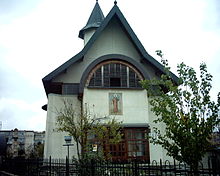Saint Andrew in Romania


The story of Saint Andrew in Romania tells that today's territory of Romania was Christianized by Saint Andrew in the 1st century AD. These claims are backed by some historians and by several Christian artifacts discovered and dated to the third century BC.[1][2]
The story is based on references by 3rd century writer Hippolytus of Rome in "On Apostles", mentioning Saint Andrew's voyage to Scythia and on works by several authors which also mention the voyage, such as: Eusebius in the Chronicles of Eusebius,[3] Origen in the third book of his Commentaries on the Genesis (254 C.E.), Usaard in his Martyrdom written between 845-865, and Jacobus de Voragine in the Golden Legend (c. 1260). Scythia generally refers to a land in what is now Romania (Scythia Minor), Ukraine and southern Russia.
The Story

Historian Alexandru Barnea states that a tale started to circulate in the first half of the 20th century.[4] It tells of Saint Andrew's arrival in Dobruja during a harsh winter, fighting wild beasts and the blizzard before reaching a cave. At the cave, Saint Andrew hit the ground with his walking stick and a spring came in to being, in the waters of which he baptized the locals and cured the ill, thus converting the whole area to Christianity.[4] This tale seems to be heavily based on the Chronicles of Eusebius.
According to some modern Romanian scholars, the idea of early Christianisation is unsustainable. They take the idea to be a part of an ideology of protochronism which purports that the Orthodox Church has been a companion and defender of the Romanian people for its entire history, which was then used for propaganda purposes during the communist era.[5] However, other works indicate that communists did not use this idea for propaganda but rather acted strongly against religion, persecuting Christians and promoting atheism as the belief system.[6]
Saint Andrew's Cave
According to Hippolyte of Antioch, (died c. 250 C.E.) in his On Apostles, Origen, in the third book of his Commentaries on the Genesis (254 C.E.), Eusebius of Caesarea in his Church History (340 C.E.), and other sources, like the Usaard's Martyrdom written between 845-865, and Jacobus de Voragine in Golden Legend (c. 1260), Saint Andrew preached in Scythia Minor. St. Philip may have also preached in the area.[7] There are toponyms and numerous very old traditions (like carols) related to Saint Andrew, many of them having probably a pre-Christian substratum.[citation needed] In Dobruja, a cave where he supposedly preached, is called "Saint Andrew's Cave" and advertised as a pilgrimage site.
According to Radu Cinpoes, there is no clear evidence concerning missionary work on the part of St. Andrew near Dobruja.[8]
Patron saint of Romania
In 1994, Saint Andrew was named the patron saint of Dobruja, in 1997 the patron saint of Romania, while in 2012, November 30 became a public holiday.[4]
Notes
- ^ Teologia, p.52
- ^ Scriitori teologi în Scytia Minor
- ^ The Library of Eusebius of Caesarea, p234
- ^ a b c Dogar, p.58
- ^ Lavinia Stan, Lucian Turcescu, Religion and Politics in Post-Communist Romania, Oxford University Press, 2007, p.48
- ^ "The Calvary of Romania".
- ^ Parry, Ken. "Romanian Christianity", The Blackwell Companion to Eastern Christianity, John Wiley & Sons, 2010, ISBN 9781444333619
- ^ Cinpoes, Radu. Nationalism and Identity in Romania, p.98, I.B.Tauris, 2010, ISBN 9780857720306
References
- Andreea Dogar, "Apostolul Andrei: Ne-a creștinat sau nu Cel Dintâi Chemat?", in National Geographic România, nr. 116, December 2012, p. 54-71
- Nicodim Nicolaescu, Teologia - year XVI, no. 4 (53), 2012
- Pr. Prof. Dr. Ion G. Coman, Scriitori teologi în Scytia Minor «De la Dunare la Mare» . Ed. Episcopiei Tomisului si Dunarii de Jos, Galati, 1979, no 72
- Andrew James Carriker, The Chronicles of Eusebius of Caesarea, 2003, ISSN 0920-623X
- The Carol of St. Andrew - http://www.ortodoxmedia.com/inregistrare/750/Colindul-Sf-Andrei
- Tudor Pamfile – Sărbătorile la români - studiu etnografic
- Gr. Grigoriu-Rigo, Medicina I
